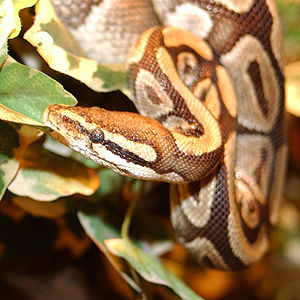Actual pythons
| Actual pythons | ||||||||||||
|---|---|---|---|---|---|---|---|---|---|---|---|---|

Ball python ( Python regius ) |
||||||||||||
| Systematics | ||||||||||||
|
||||||||||||
| Scientific name | ||||||||||||
| python | ||||||||||||
| Daudin , 1803 |
The real pythons ( Python ) are a genus of snakes from the family of pythons (Pythonidae). The genus includes nine species that colonize the tropics of Africa and Asia. The grammatical gender of an item is technically masculine , although the Duden also allows the feminine form.
description
All species in the genus are medium to very large. Like all pythons , they are non-toxic and kill their prey by entangling them. All pythons have a pit organ , so they can detect infrared rays and hunt in the dark. Other common features include the dentition of the premaxillary , the enormously flexible lower jaw and the very mobile upper jaw bones, as well as reproduction through the laying of eggs ( oviparia ).
distribution
The distribution area includes tropical Africa and Asia. Four species are found in Africa, the remaining five in southeast Asia.
Way of life
All species are predominantly nocturnal and feed primarily on small to medium-sized vertebrates. The prey is recognized and located via heat sense organs, the labial pits . The prey is then seized, suffocated by the extremely powerful body loops and completely choked down. Digestion is very quick, a whole rabbit is completely digested in 4–5 days. This is possible because the organs that are significantly involved in digestion (stomach, intestines and liver) grow threefold during digestion. Digestion is an extremely complex process, so that almost half of the added calorific value is used again during the digestion process.
species
Ten types are counted among the real pythons:
- Angolapython ( Python anchietae ): total length 1 to 2 m; endemic to Angola and Namibia
- Dark Tiger Python ( Python bivittatus ): total length 2 to 4 m, max. just over 5 m; large parts of Southeast Asia
- Borneo short-tailed python ( Python breitsteini ): total length 1 to 2 m; endemic to Borneo
- Blood python ( Python brongersmai ): total length 1 to 2 m, max. about 2.6 m; Parts of Southeast Asia
- Sumatran short-tailed python ( Python curtus ): total length 1 to 2 m; endemic to the southern part of Sumatra
- Python kyaiktiyo : Myanmar
- Light Tiger Python ( Python molurus ): total length 2 to 4 m, max. just over 5 m; large parts of South Asia
- Southern rock python ( Python natalensis ): total length 2.8 to 4 m, max. just over 5 m; southern africa
- Ball python ( Python regius ): total length 1 to 2 m; West and Central Africa
- Northern rock python ( Python sebae ): total length 2.7 to 4.6 m, max. just over 5 m; West, Central and East Africa
Until a few years ago, P. Breitensteini and P. brongersmai were considered subspecies of P. curtus .
The reticulated python ( Malayopython reticulatus ) and the Timorpython ( Malayopython timoriensis ) were previously grouped as Python reticulatus and Python timoriensis, respectively, to the actual pythons. In 2008 they were moved to the new genus Malayopython , as new studies had shown that these two species form the sister taxon of all pythons in Australia and Papua New Guinea and are therefore more closely related to them than to the other species of the genus Python .
In a study from 2009 Jacobs, Auliya and Böhme raised the dark tiger python, which was previously regarded as a subspecies of the light tiger python ( Python molurus ), at species level. Accordingly, with the dark tiger python ( Python bivittatus ), ten species can be distinguished as actual pythons.
Protection status
Most of the snakes of the Pythonidae family are listed in Appendix B of the European Species Protection Ordinance and may be kept without a permit. According to the Federal Species Protection Ordinance, however, the attitude towards the responsible state authority is notifiable.
P. molurus molurus, the light tiger python is listed in Appendix A of the European Species Protection Ordinance and may not be kept without permission.
See also
swell
Individual evidence
- ↑ Duden search: Python
- ^ Python in The Reptile Database
- ^ H. Saint Girons: Les serpents du Cambodge. Mémoires du Muséum national d'Histoire naturelle, Series A 1972, pp. 40-41.
- ^ A b Hans J. Jacobs, Mark Auliya and Wolfgang Böhme: On the taxonomy of the dark tiger python, Python molurus bivittatus Kuhl, 1820, especially the population of Sulawesi . In: Sauria . tape 31 , no. 3 , 2009, p. 5-16 .
- ^ A b F. Wall: A popular treatise on the common Indian snakes - The Indian Python. Journal of the Bombay Natural History Society Volume 21, 1912, pp. 447-476; online from p. 419 .
- ↑ JS Keogh, DG Barker, R. Shine: Heavily exploited but poorly known: systematics and biogeography of commercially harvested pythons (Python curtus group) in Southeast Asia. Biological Journal of the Linnean Society, 73: 113-129, 2001.
- ↑ George R. Zug, Steve W. Gotte, & Jeremy F. Jacobsa: Pythons in Burma: Short-tailed python (Reptilia: Squamata). Proceedings of the Biological Society of Washington 124 (2): 112-136. 2011 doi : 10.2988 / 10-34.1
- ↑ S. Spawls, K. Howell, R. Drewes, J. Ashe: A Field Guide to the Reptiles of East Africa. Academic Press 2002, ISBN 0-12-656470-1 , pp. 305-310.
- ^ WR Branch, WD Haacke: A Fatal Attack on a Young Boy by an African Rock Python Python sebae. Journal of Herpetology 14, No. 3, 1980, pp. 305-307.
- ^ CRS Pitman: A guide to the snakes of Uganda. Codicote Wheldon & Wesley, Ltd, 1974, ISBN 0-85486-020-7 , pp. 67-71.
- ^ Malayopython in The Reptile Database
- ^ Python in The Reptile Database
literature
- JG Walls: The Living Pythons. TFH Publications, 1998.